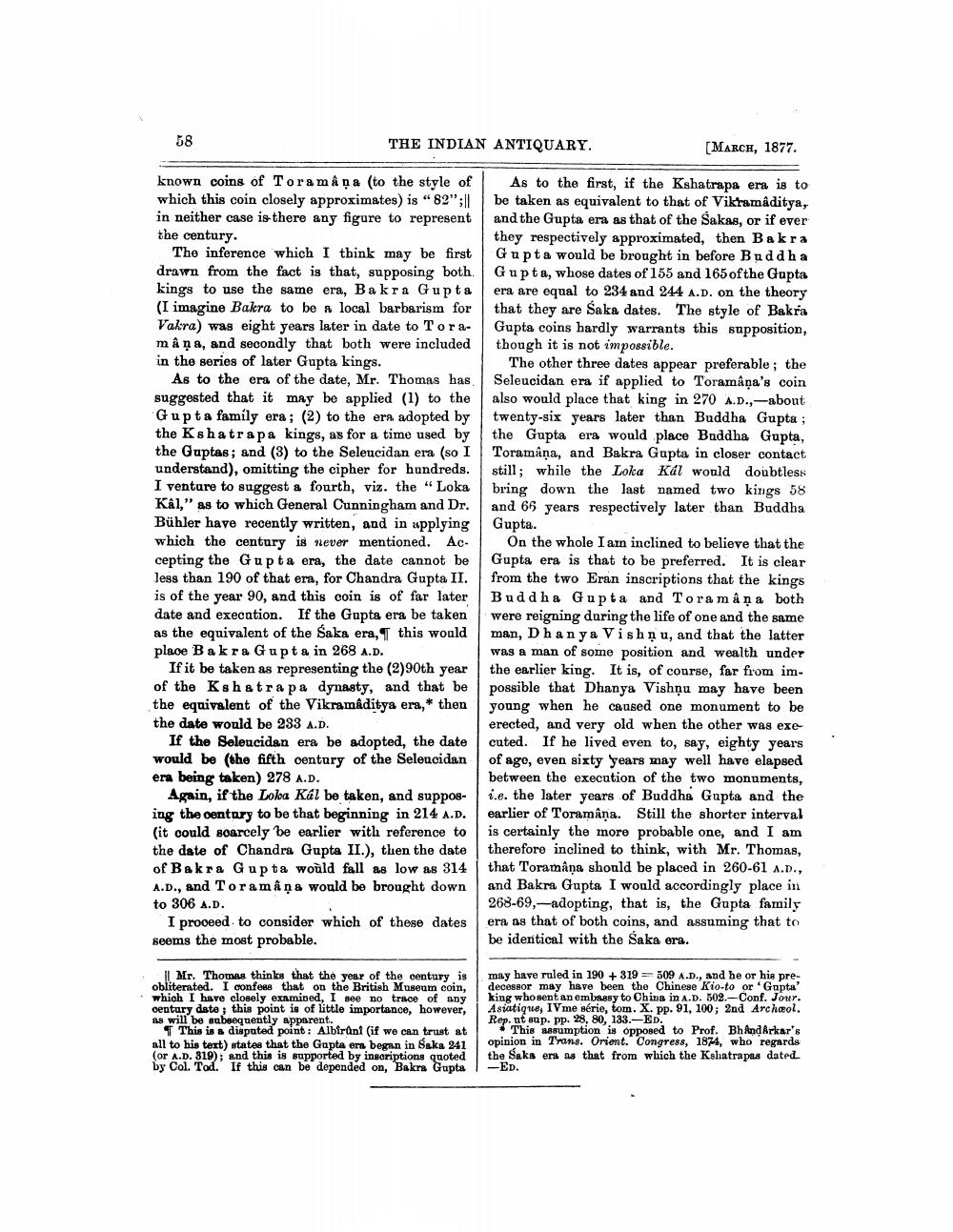________________
58
THE INDIAN ANTIQUARY.
[MARCH, 1877.
known coins of Toramapa (to the style of which this coin closely approximates) is "82":|| in neither case is there any figure to represent the century.
The inference which I think may be first drawn from the fact is that, supposing both. kings to use the same era, Bakra Gupta (I imagine Bakra to be a local barbarism for Vakra) was eight years later in date to Toramâņa, and secondly that both were included in the series of later Gupta kings.
As to the era of the date, Mr. Thomas has suggested that it may be applied (1) to the Gupta family era; (2) to the era adopted by the Kshatrapa kings, as for a time used by the Guptas; and (3) to the Seleucidan era (so I understand), omitting the cipher for hundreds. I venture to suggest a fourth, viz. the "Loka Kál," as to which General Cunningham and Dr. Bühler have recently written, and in applying which the century is never mentioned. Accepting the Gupta era, the date cannot be less than 190 of that era, for Chandra Gupta II. is of the year 90, and this coin is of far later date and execution. If the Gupta era be taken as the equivalent of the Saka era, T this would place Bakra Gupta in 268 A.D.
If it be taken as representing the (2)90th year of the Kshatra pa dynasty, and that be the equivalent of the Vikramaditya era,* then the date would be 233 A.D.
If the Seleucidan era be adopted, the date would be the fifth century of the Seleucidan era being taken) 278 A.D.
Again, if the Lola Kál be taken, and supposing the century to be that beginning in 214 A.D. (it could soarcely be earlier with reference to the date of Chandra Gupta II.), then the date of Bakra Gupta woùld fall as low as 314 A.D., and Toramâna would be brought down to 306 A.D.
I proceed to consider which of these dates seems the most probable.
As to the first, if the Kshatrapa era is to be taken as equivalent to that of Vikramaditya, and the Gupta era as that of the Sakas, or if ever they respectively approximated, then Bakra Gupta would be brought in before Buddha Gupta, whose dates of 155 and 165 of the Gupta era are equal to 234 and 244 A.D. on the theory that they are Saka dates. The style of Bakra Gupta coins hardly warrants this supposition, though it is not impossible.
The other three dates appear preferable; the Seleucidan era if applied to Toramåņa's coin also would place that king in 270 A.D., -about twenty-six years later than Buddha Gupta ; the Gupta era would place Buddha Gupta, Toramåņa, and Bakra Gupta in closer contact still; while the Loka Kal would doubtless bring down the last named two kings 58 and 66 years respectively later than Buddha Gupta.
On the whole I am inclined to believe that the Gupta era is that to be preferred. It is clear from the two Eran inscriptions that the kings Buddha Gupta and Tora måna both were reigning during the life of one and the same man, Dhanya Vishnu, and that the latter was a man of some position and wealth under the earlier king. It is, of course, far from impossible that Dhanya Vishņu may have been young when he caused one monument to be erected, and very old when the other was exe cuted. If he lived even to, say, eighty years of ago, even sixty years may well have elapsed between the execution of the two monuments, i.e. the later years of Buddha Gupta and the earlier of Toramana. Still the shorter interval is certainly the more probable one, and I am therefore inclined to think, with Mr. Thomas, that Toramana should be placed in 260-61 A.D., and Bakra Gupta I would accordingly place in 268-69,-adopting, that is, the Gupta family era as that of both coins, and assuming that to be identical with the Saka era.
|| Mr. Thomas thinks that the year of the century is obliterated. I confess that on the British Museum coin, which I have closely examined, I see no trace of any oentury date ; this point is of little importance, however, 4s will be sabeequently apparent.
This is a disputed point: Albirani (if we can trust at all to his text) states that the Gapta era began in Saka 241 (or A.D. 319), and this is supported by inscriptions quoted by Col. Tod. If this can be depended on, Bakra Gupta
may have ruled in 190 + 319 = 509 A.D., and he or his predecessor may have been the Chinese Kio-to or 'Gupta' king whosent an embassy to China in A.D. 502.-Conf. Jour. Asiatique, IV me série, tom. X. pp. 91, 100; 2nd Archeol. Rep. at sup. pp. 28, 80, 133.-ED.
• This assumption is opposed to Prof. Bh And Arkar's opinion in Trans. Orient. Congress, 1874, who regards the Saka era as that from which the Kshatrapas dated. -ED.




